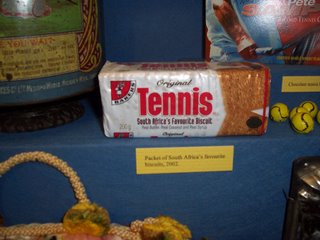
Thursday, December 28, 2006
Trafalgar Square vanoggend (28/12/2006)

Wednesday, December 13, 2006
Princess lights up Christmas tree

The lighting of the Trafalgar Square Christmas Tree, a highlight of London's festive period, has taken place.
A Norwegian Spruce, complete with garlands of energy-efficient light bulbs, was switched on by Crown Princess Mette-Marit of Norway.
The huge tree has been an annual gift from Norway since 1947 in gratitude for Britain's support in World War II.
It was felled from forests near Oslo in November and brought to Britain by sea.
A specialist rigging team erected it in the square, where it remains until 6 January before being recycled.
London Mayor Ken Livingstone said: "For many Londoners the Christmas tree and carol singing in Trafalgar Square signal the countdown to Christmas."
The princess was accompanied by her mother Crown Princess Mette-Marit for the switching on ceremony.
Wednesday, November 29, 2006
En dis ook nie net by jaareindfunksies waar daar vreemde geskenke uitgedeel word nie ;-)
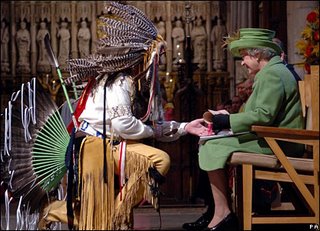
Native American honoured by Queen
The Queen is handed a copy of the original 18th century petitionThe Queen was given a peace pipe at a memorial to a Native American chieftain to symbolise the righting of a wrong.
Accompanied by the Duke of Edinburgh, she paid her respects to Mahomet Weyonomon, of the Mohegan tribe, who died of smallpox in London in 1736.
Tribal leaders in traditional regalia blessed a memorial stone in his honour.
Mahomet had travelled from Connecticut to petition George II about the capture of his tribe's land by English settlers but died before he met the king.
Foreigners were barred from being buried in the City of London so his body was interred in an unmarked grave.
'Proper burial'
The Queen and the duke were joined by tribal spiritual leader Bruce "Two Dogs" Bozsum and other Mohegans wearing deerskin leggings and headdresses made with turkey and eagle feathers at the memorial ceremony at Southwark Cathedral on Wednesday.
She was presented with a scroll containing a copy of the original petition and a red stone peace pipe.
Mr Bozsum said: "We are glad that we have given him a proper burial now.
We cannot right past wrongs but we can remember them and transform them
Very Rev Colin Slee, Dean of Southwark"The Queen said she was very pleased , very honoured to see us and have us here. It meant a lot to us. This is the highlight of my life to meet the Queen."
The Very Rev Colin Slee, Dean of Southwark, gave an address about the significance of the events.
He said: "We are here to dedicate a memorial, to complete an unfinished commission, to remember we share with the people of the United States a story which, like all human conduct, is marked by good and bad.
"We cannot right past wrongs but we can remember them and transform them to inspire better conduct throughout humanity now and in years to come."
The Queen also unveiled a stone sculpture, carved by Peter Randall Page, which stands in the south churchyard.
The five-tonne piece of pink granite came from the tribal reserve in New England. It is customary to name a boulder after a chief who has died.
En dis nie net in SA waar name verander nie :-)
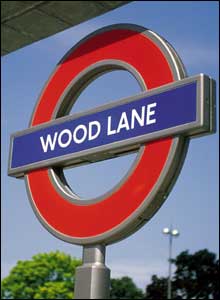 Tube map to get new station names
Tube map to get new station namesWood Lane and Shepherd's Bush Market will join the Tube mapThe Tube map is to get two new names in west London, it has been announced.
A new station called Wood Lane is to be built on the Hammersmith and City Line and Shepherd's Bush, on the same Line, will be renamed Shepherd's Bush Market.
There are currently two Shepherd's Bush stops on the Hammersmith and City Line and the Central Line and it is hoped the changes will end any confusion.
Wood Lane station, which should open in 2008, will be built between Shepherd's Bush Market and Latimer Road.
It will be the first time in more than 70 years there has been a new addition to an existing route which has not been extended.
London mayor Ken Livingstone said: "The naming of the new Wood Lane station and the renaming of Shepherd's Bush is the latest step in the massive improvements of transport links for west London.
"These improvements will bring in regeneration to the area and give this part of the capital a world-class service for the first time."
Energy row over Christmas lights
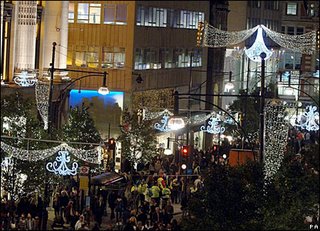
On Thursday girl band All Saints switched on the lights on the shopping street. The 260,000 bulbs will be on 24-hours-a-day until 6 January.
Organisers said they were using low energy bulbs and consume 50% less power than four years ago.
But Liberal Democrats on the London Assembly have called for renewable energy to be used.
"Let's remember the lights are a major draw for London. We have over 40 million visitors coming from London, the UK and overseas to come and see these lights."
Olimpiese Spele 2012
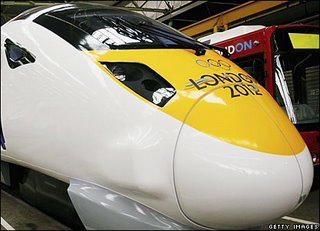
Olympic Games face huge tax bill
VAT on construction work was not included in the original bidOrganisers of the 2012 London Olympic Games have discovered they may be facing a huge additional tax bill.
Tory Olympic spokesman Hugh Robertson said the government had assured him the £2.38bn cost of construction sites would not be subject to VAT.
But the Treasury is demanding the tax, and has said European regulations state it cannot be seen to be supporting the organisers of the event.
It is in discussions with the Olympic Delivery Authority over the matter.
When the London bid was submitted to the International Olympic Committee in 2004 it included an estimate for building various sites in east London.
'Specific undertakings'
It estimated the cost at £2.38bn, but that did not include VAT on construction work or other costs.
Mr Robertson said forcing the Olympic organisers to pay VAT at a rate of as much as 17.5% would be devastating.
He said: "The issue of VAT on the Olympic sites was raised by the Conservative Party during the passage of the London Olympics and Para-Olympics Bill, and we received specific undertakings from the government that the Treasury would waive these costs.
It would be wrong for there to be any further council tax increase
London mayor, Ken Livingstone
"It would be catastrophic if (Chancellor) Gordon Brown were to renege on that commitment now."
A Treasury spokesperson said: "We are in discussion with the DCMS (Department of Culture, Media and Sport) and the Olympic Delivery Authority (ODA) issues and we are confident we can find a way forward.
"But it would not be helpful to give a running commentary on those discussions."
Mayor of London, Ken Livingstone said: "It would be wrong for there to be any further council tax increase, I will not be proposing or making one, so there will not be one."
Officials at the Olympic Delivery Authority declined to comment.
New hybrid bus
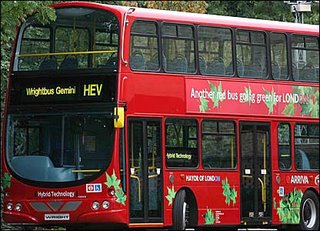
Hybrid double-decker bus unveiled
The bus will produce 40% less emissionsMayor Ken Livingstone has unveiled London's first hybrid double-decker bus in a bid to make commuting in the city a greener experience.
Built at a cost of £285,000, the bus runs on a combination of diesel and electricity and will produce 40% less carbon dioxide (CO2) emissions.
The mayor said the bus was the first of a fleet that will make London "one of the world's most sustainable cities".
The hybrid bus will be on the road by the end of November.
Six single-deck hybrid buses are currently operating in London.
A battery pack, which is run by a Euro IV complaint Diesel engine, powers the wheels of the new hybrid bus through an electric motor.
But he said it was a good opportunity for such a company.
Tuesday, July 18, 2006
Royal Courts of Justice - the High CourtStrand, London WC1

The Royal Courts of Justice are the nation's main civil courts.
Here, the High Court presides over the most serious civil trials in the country including divorce, libel, civil liability and appeals. Criminal cases are handled by the Old Bailey.
The imposing Victorian Gothic building, designed by G E Street, was opened by Queen Victoria in 1882, the architect's finest achievement, and the last major Gothic revival building in London.
Made from 35 million bricks faced with Portland stone, the Royal Courts of Justice are said to contain 1,000 rooms and 3.5 miles of corridors. The stress of building was so great that it caused Street's early death.
The interior of the building is as magnificent as the façade.
The public are admitted to all 88 court rooms and can come and go as they please, although Judges will not suffer interruptions when they are passing judgement or witnesses are taking oaths.
Prominent lists in the central hall indicate which case is being held in which court and how far the proceedings have gone.
The Royal Courts of Justice also contains a small exhibition of legal dress.
Tuesday, July 11, 2006
Hittegolf!
Lord Nelson word (weer) onthul
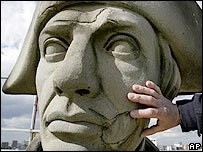
Restored naval hero is revealed
The years, and the pigeons, have taken their toll on Nelson's visageAfter having his arm X-rayed and being pigeon-proofed, the renovated statue of Lord Nelson is due to be unveiled.
The world famous column in Trafalgar Square has undergone a four month restoration, its first since 1986.
As part of the £420,000 refurbishment, Nelson's left arm, which was struck by lightning in the 1880s, was repaired.
Bronze straps on the arm were removed, and previously unavailable Craigleith stone, the material used to make the statue, was used to restore the arm.
Since the closure of the Craigleith quarry in Scotland 60 years ago, getting hold of the stone has been virtually impossible the company behind the restoration said and previous renovators had patched up Nelson using a mixture of mortar and cement.
Donated stone
The Craigleith stone used to repair Nelson was salvaged during a restoration of Donaldson's School for the Deaf, an A-listed building in Edinburgh, and was donated to the Nelson's Column restoration by Scottish company Watson Stonecraft.
The Grade I listed column was completed in 1843 to commemorate Admiral Horatio Nelson, who died at the Battle of Trafalgar in 1805.
It was designed by William Railton and cost £47,500. The top is decorated with bronze acanthus leaves.
The square pedestal has four bronze panels, cast from captured French guns, depicting Nelson's four great victories.
We leave Nelson looking much better than he has for many years
Restorer Adrian Attwood
The Mayor of London Ken Livingstone, who commissioned the restoration, said: "Using the original stone has allowed the restorers to take an authentic approach to the conservation of a monument built 163-years ago.
"It will ensure that this unique monument can be enjoyed by Londoners and visitors to the capital for many years to come."
It has been cleaned several times but the whole monument has only undergone restoration twice previously, in 1968 and in 1986.
Adrian Attwood, from David Ball Restoration Limited, which carried out the restoration work, said: "Our philosophy at the start of the project was that we would repair Nelson as carefully as if it were a statue at ground level.
"Using the Craigleith stone and repairing Nelson's arm means that we have exceeded our own expectations. We leave Nelson looking much better than he has for many years."
For the first time a laser survey was carried out to check the dimensions of Nelson's Column which reveals it is shorter than previously thought, standing at just over 169ft (51.5m) when measured from street level to the top of the Nelson statue.
Op Anca se verjaarsdag...
 ... het Paddington Bear na Paddington stasie toe gery. Dit was deel van die koningin se amptelike verjaarsdag die volgende dag!
... het Paddington Bear na Paddington stasie toe gery. Dit was deel van die koningin se amptelike verjaarsdag die volgende dag!Paddington visit from famous bear
Paddington Bear, one of the stars of this weekend's Royal Children's Party, made a brief visit to the station he was named after on Friday.
The duffle coat-wearing bear strode down platforms on Friday morning, greeting commuters and tucking into his favourite snack - a marmalade sandwich.
Paddington will be going to the Children's Literature Garden Party held at Buckingham Palace on Sunday.
The party is one of the celebrations marking the Queen's 80th birthday.
Library festival
Paddington shares a birthday with the Queen - and also has another birthday on Christmas Day.
Michael Bond, the man who created the marmalade-fancying bear from Peru, will attend the party.
Up to 800 libraries across the UK will be taking part in a literary long weekend to try and get children to read for fun.
The Queen will send a message of support to libraries taking part.
On Sunday the grounds of Buckingham Palace will be transformed, featuring characters from the Big Friendly Giant and Winnie The Pooh.
Friday, June 23, 2006
Anca verjaar vandag! (23 Junie)

June 23 is the 174th day of the year (175th in leap years) in the Gregorian Calendar, with 191 days remaining.
Events
1305 - Flemish-French peace treaty signed at Athis-sur-Orge.
1314 - Start of the Battle of Bannockburn south of Stirling, Edward II of England & Robert I of Scotland met in battle. Scotland won and Edward fled the field and Scotland.
1532 - Henry VIII & François I sign secret treaty against Emperor Charles V.
1611 - The mutinous crew of Henry Hudson's fourth voyage sets Henry, his son and seven loyal crew members adrift in an open boat in the Atlantic Ocean; they are never heard from again.
1661 - Marriage contract between Charles II of England & Catharina of Portugal.
1683 - William Penn signs friendship treaty with Lenni Lenape Indians in Pennsylvania.
1713 - French residents of Acadia given one year to declare allegiance to Britain or leave Nova Scotia Canada. [1]
1757 - Battle of Plassey - 3000 British troops under Robert Clive defeat a 50,000 strong Indian army under Siraj Ud Daulah at Plassey.
1758 - Seven Years' War: Battle of Krefeld - British forces defeat French troops at Krefeld in Germany.
1760 - Seven Years' War: Battle of Landshut - Austria beats Prussia.
1794 - Empress Catherine II grants Jews permission to settle in Kiev.
1810 - John Jacob Astor forms the Pacific Fur Company.
1812 - Napoleon begins the famous offensive on Russia, which fails horribly.
1812 - War of 1812: Great Britain had revoked the restrictions on American commerce, thus eliminating one of the chief reasons for going to war.
1858 - Six-year-old Edgardo Mortara is seized by Papal authorities.
1860 - The US Congress establishes the Government Printing Office.
1865 - American Civil War: At Fort Towson in Oklahoma Territory Confederate General Stand Watie surrenders the last significant rebel army.
1887 - The Rocky Mountains Park Act becomes law in Canada, creating that nation's first national park, Banff National Park. [2]
1888 - Frederick Douglass is the first African-American nominated for US president.
1894 - International Olympic Committee is founded at the Sorbonne, Paris, at the initiative of Baron Pierre de Coubertin.
1919 - Defeat of German forces at Cesis in northern Latvia during Estonian Liberation War, now celebrated annually as Estonian Victory Day.
1931 - Wiley Post and Harold Gatty take off from Roosevelt Field, Long Island in an attempt to accomplish the first round-the-world flight in a single-engine plane. [3]
1938 - The Civil Aeronautics Act is signed into law, forming the Civil Aeronautics Authority in the United States.
1938 - Marineland opens near St. Augustine, Florida.
1940 - World War II: German leader Adolf Hitler surveys newly defeated Paris in now occupied France.
1941 - Lithuanian Activist Front initiates Lithuanian 1941 independence from the Soviet Union; it lasted only briefly as the Nazis occupied Lithuania a few weeks later.
1944 - Thomas Mann becomes a US citizen.
1947 - The United States Senate follows the United States House of Representatives in overriding U.S. President Harry S. Truman's veto of the Taft-Hartley Act.
1955 - In the Strahov Stadium in Prague the 1st all-national Spartakiáda begins.
1956 - Gamal Abdel Nasser elected president of Egypt.
1958 - The Dutch Reformed Church accepts women ministers.
1959 - Convicted Manhattan Project spy Klaus Fuchs is released after only nine years in prison and allowed to emigrate to Dresden, East Germany (where he resumed a scientific career).
1959 - A fire in a resort hotel in Stalheim, Norway kills 34 people.
1967 - Cold War: U.S. President Lyndon B. Johnson meets with Soviet Premier Aleksei Kosygin in Glassboro, New Jersey for the three-day Glassboro Summit Conference.
1968 - 74 are killed and 150 injured in a soccer stampede towards a closed exit in a Buenos Aires stadium.
1969 - Warren E. Burger is sworn in as chief justice of the United States Supreme Court by retiring chief Earl Warren.
1972 - Watergate Scandal: U.S. President Richard M. Nixon and White House chief of staff H. R. Haldeman are taped talking about using the Central Intelligence Agency to obstruct the Federal Bureau of Investigation's investigation into the Watergate break-ins.
1985 - A Boeing 747 carrying Air India Flight 182 blew-up 31,000 feet (9500 m) above the Atlantic Ocean, South of Ireland, killing all 329 aboard.
1990 - Moldavia declares independence.
1991 - Sonic the Hedgehog, one of the most popular video game characters in history, makes his debut in his self-titled video game.
1996 - The Nintendo 64, successor to the Super Nintendo Entertainment System is released in Japan.
Births
47 BC - Pharaoh Ptolemy XV of Egypt
1433 - Francis II, Duke of Brittany (d. 1488)
1456 - Margaret of Denmark, wife of James III of Scotland (d. 1486)
1534 - Oda Nobunaga, Japanese warlord (d. 1582)
1596 - Johan Banér, Swedish soldier (d. 1641)
1612 - André Tacquet, Belgian mathematician (d. 1660)
1668 - Giambattista Vico, Italian philosopher and historian (d. 1744)
1683 - Etienne Fourmont, French orientalist (d. 1745)
1716 - Fletcher Norton, 1st Baron Grantley, English politician (d. 1789)
1750 - Dolomieu, French geologist (d. 1801)
1763 - Josephine de Beauharnais, Empress of France (d. 1814)
1800 - Karol Marcinkowski, Polish physician and social activist (d. 1846)
1824 - Carl Reinecke, German musician and composer (d. 1910)
1884 - Cyclone Taylor, professional ice hockey player (d. 1979)
1888 - Bronson M. Cutting, American politician
1889 - Anna Akhmatova, Russian poet (d. 1966)
1894 - Alfred Kinsey, American entomologist and sexologist (d. 1956)
1894 - King Edward VIII of the United Kingdom (d. 1972)
1903 - Paul Joseph James Martin, Canadian politician (d. 1992)
1907 - James Meade, English economist, Nobel Prize laureate (d. 1995)
1909 - David Lewis, Canadian lawyer and politician (d. 1981)
1910 - Jean Anouilh, French dramatist (d. 1987)
1910 - Gordon B. Hinckley, president of The Church of Jesus Christ of Latter-day Saints
1910 - Milt Hinton, American jazz bassist (d. 2000)
1912 - Alan Turing, English mathematician (d. 1954)
1916 - Len Hutton, English cricketer (d. 1990)
1919 - Muhammad Boudiaf, Algerian political leader (d. 1992)
1927 - Bob Fosse, American choreographer (d. 1987)
1929 - June Carter Cash, American singer (d. 2003)
1935 - Maurice Ferre, former Puerto Rican mayor of Miami
1936 - Costas Simitis, Prime Minister of Greece
1937 - Martti Ahtisaari, President of Finland
1940 - Adam Faith, English singer and actor (d. 2003)
1940 - Lord Irvine of Lairg, Scottish Lord Chancellor
1940 - Wilma Rudolph, American runner (d. 1994)
1940 - Stuart Sutcliffe, first bassist with The Beatles (d. 1962)
1941 - Robert Hunter, American lyricist and poet (The Grateful Dead)
1943 - James Levine, American conductor
1943 - Vint Cerf, American Internet pioneer
1946 - Ted Shackleford, American actor
1947 - Bryan Brown, Australian actor
1948 - Clarence Thomas, U.S. Supreme Court Justice
1948 - Darhyl S. Ramsey, American author and professor of music education
1955 - Glenn Danzig, American musician (The Misfits and Danzig)
1955 - Jean Tigana, French footballer
1957 - Frances McDormand, American actress
1961 - Zoran Janjetov, Serbian comic artist
1962 - Chuck Billy, American singer
1963 - Colin Montgomerie, Scottish golfer
1964 - Joss Whedon, American producer, director, and screenwriter
1964 - Yun Lou, Chinese gymnast
1965 - Paul Arthurs, British guitarist (Oasis)
1966 - Chico DeBarge, American musician (DeBarge)
1971 - Felix Potvin, Canadian professional hockey goaltender
1972 - Selma Blair, American actress
1972 - Zinedine Zidane, French footballer
1973 - Marie N, Latvian singer
1975 - Kevin Dyson, American football player
1976 - Anca Marks - die coolste girl in die hele UK!
1976 - Brandon Stokley, American football player
1976 - Patrick Monahan, British comedian
1976 - Patrick Vieira, French footballer
1977 - Jason Mraz, American singer and songwriter
1979 - LaDainian Tomlinson, American football player
1980 - Ramnaresh Sarwan, Guyanese cricketer
Holidays and observances
Jāņi (Līgo) - Latvia
Midsummer's Eve, Christianized the eve of the feast of Saint John the Baptist, is celebrated in much of Northern Europe and the British Islands
Victory Day - Estonia
Saint Jonas Day - Lithuania
Father's Day - Poland
Thursday, June 22, 2006
Lizard brightens UK politics 21/06/2006 21:09 - (SA)
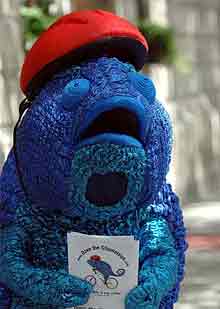
Dave the Chameleon, an actor dressed up and sent by Britain's governing Labour Party to trail opposition Conservative leader David Cameron. (Steve Parsons/AP)
London - Leapin' lizards! British politics is going to the reptiles.
The governing Labour Party has been sending an actor dressed as a big, blue chameleon to trail opposition Conservative leader David Cameron.
The political symbolism is obvious, but some say it could backfire - the creature may be too cute for the criticism to stick.
"We're cheered to see him because he's just so sweet," said Gabby Bertin, a Cameron spokesperson, on Wednesday.
Cameron, 39, poses the biggest threat Prime Minister Tony Blair has faced from an opposition leader since he came to power in 1997.
The Tories have got a boost in the polls since Cameron took charge in December and support for Labour has been slipping badly - although that may say more about voters' negative feelings toward the prime minister than their fondness for Cameron.
The new leader is trying to overhaul his long-sidelined party's image as out of touch with ordinary voters.
'Flip-flops' on issues
He's pulling the Tories to the centre and pushing issues like the environment, to which they previously paid little attention.
Labour accuses him of changing his views to appeal to whatever audience he happens to be addressing.
It sent "Dave the Chameleon" - who made his debut in a cartoon ad ahead of last month's local elections - to distribute leaflets outside a speech Cameron gave on Tuesday, complete with a bike helmet, a nod to the politician's fondness for cycling.
"He flip-flops from one position to another, depending on whatever he thinks you want to hear," said one Labour message.
Cameron has responded lightheartedly.
Too cute for hate figure
He said when the campaign ad appeared that the chameleon had become his young children's favourite cartoon character. He jokingly addressed a group of journalists as "my fellow reptiles".
Times columnist Ann Treneman warned that Labour's effort to skewer Cameron with humour wouldn't work.
"The main problem with the lizard is that it is too cute to become a hate figure," she wrote. "Soon people will be wanting its autograph."
Tuesday, June 20, 2006
Eurostar

Eurostar is a train service that connects London (Waterloo station) with Paris (Gare du Nord), Lille and Brussels (Gare du Midi). Trains cross the English Channel via the Channel Tunnel, or "Chunnel". The French and Belgian sections of the route use the same high-speed rail lines as the TGV and Thalys, and in England a new line is being built to the same standard. This is a two-phase project known as the Channel Tunnel Rail Link project (CTRL).
The first revenue-earning Eurostar trains ran in November 1994. Eurostar has established a dominant share of the market on the routes it serves — 68% for London-Paris and 63% for London-Brussels, as of November 2004. The company points out that these passenger figures represent a saving of 393,000 carbon dioxide-producing short-haul flights.
The journey time from London to Paris is currently 2 hours 35 minutes; London to Brussels is 2 hours 20 minutes. These times will be cut by 20 minutes in 2007 when the construction of the second phase of CTRL is completed, bringing the British portion of the route up to the same standards as the French and Belgian sections. Completion of the CTRL will also allow a significant increase in the number of Eurostar trains serving London. After phase two is completed, up to eight trains per hour in each direction will be able to travel from London to the continent, as timetabling will be unaffected by peak hour restrictions at London Waterloo and conflicts between Waterloo and Fawkham Junction.
Some Eurostar services stop en route at Ashford International and at Calais-Fréthun and Lille in northern France in addition to the three destination cities. Eurostar also run services to Disneyland Paris, to Avignon in summer, and - in the skiing season - to Bourg-Saint-Maurice, Aime-la-Plagne and Moutiers in the French Alps.
From 2007 all Eurostar trains will be routed through the CTRL to a new London terminus at St Pancras. The company had intended to retain some services to the existing Waterloo terminal, but this was ruled out on cost grounds. Some trains will additionally serve new stations at Ebbsfleet near Dartford in northwest Kent (Ebbsfleet International station) and Stratford International station in east London (near Stratford station, or Stratford Regional station as it will be called when Stratford International station is opened)
Eurotunnel, the company that built and runs the Channel Tunnel, is a completely separate entity from Eurostar.
Somerset House
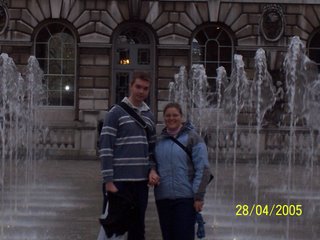
Somerset House is a large building situated on the south side of The Strand in central London, overlooking the River Thames, just east of Waterloo Bridge. The central block of the Neoclassical building, the outstanding project of the architect Sir William Chambers, dates from 1776–1796. It was extended by classical Victorian wings to north and south. A building of the same name was first built on the site more than two centuries earlier.
Somerset House takes its name from the London home of Edward Seymour, Duke of Somerset, who commissioned a riverside mansion on the site in 1547, one of a row of noblemen's houses with fronts along the Strand. The building was constructed from stone removed from some of the chantries and cloisters at St. Paul's Cathedral which were demolished at the behest of Somerset and other leading Protestant nobles as part of the ongoing Dissolution of the Monasteries.
When Somerset fell from grace in 1551 (being executed for treason the following year), the building passed to the Crown and was used by Princess Elizabeth for some years before she was crowned Queen Elizabeth I in 1558.
During the reign of King James I, the building became the London residence of his wife Anne of Denmark and was renamed "Denmark House". She commissioned a number of expensive additions and improvements, some to designs by Inigo Jones. This expansion of the building continued during Charles I's reign, including the then highly controversial addition by his wife, Henrietta Maria, of a Roman Catholic chapel (also designed by Jones – who was later to die at Somerset House, in 1652).
After the English Civil War and the Restoration, Somerset House once again became a royal residence, and was refurbished by Sir Christopher Wren in 1685. During the 18th century, however, the building ceased its royal associations. Though the view from its terraced riverfront garden, open to the public, was painted twice on his London visit by Canaletto (looking upriver and down), it was used for storage, as a residence for visiting overseas dignatories and as a barracks for troops. Suffering from neglect, demolition began in 1775.
As well as the Royal Academy, Somerset House was fitted out to house the Royal Society and the Society of Antiquaries. These, and the Geological Society, moved to Burlington House in Piccadilly in the early 19th century.
In the late 20th century the building was reinvigorated as a centre for the visual arts. The first institution to move in was the Courtauld Institute of Art, including the Courtauld Gallery, which has an important collection of old master and impressionist paintings. In the late 1990s the main courtyard ceased to be a civil service carpark, and the main terrace overlooking the Thames was refurbished and opened to the public, these alterations being overseen by the leading conservation architects Donald Insall & Associates.
A visitor centre featuring audiovisual displays on the history of the building; the gilded Lord Mayor of London's state barge; and a shop and cafe were opened in the wing overlooking the river. The Gilbert Collection of decorative arts, and the Hermitage Rooms, which stage exhibitions of items loaned from the Hermitage Museum in St Petersburg, moved into the same area. The Eastern wing is largely occupied by King's College London.
In the winter the central courtyard is home to an open air ice rink. At other times an array of fountains dispay vertical jets of water rising to random heights.
Somerset House was also the main location for the BBC's New Year Live television show, presented by Natasha Kaplinsky, which celebrated the arrival of the year 2006.
Friday, June 16, 2006
Camden Town
Camden Town is a place in the London Borough of Camden. It is an inner-city district located 2.3 miles (3.7 km) north north-west of Charing Cross, famous for its crowded market and as a centre for alternative lifestyles. The area is popular with students, including those from overseas. The area has a reputation for readily available drugs.
Attractions
The Regent's Canal runs through the north end of Camden Town and is a popular walk in summer. Close by is Regent's Park with the London Zoo sited in the north side. The Roundhouse is a music venue located in a converted railway roundhouse, which is currently (May 2003) being refurbished. It was originally an engine shed for the London and Birmingham Railway. Apart from the eponymous market, there is a selection of shops, bars and cafes, which are more mainstream on the High St. south of the tube station. The area has several language schools, such as Camden College of English, located at the Chalk Farm side of the market.
Camden market
Camden is well-known for Camden Market which is made up of Buck Street Market, Stables Market, Inverness Street Market, Camden Canal Market, and Camden Lock Market, and an indoor market located in the Electric Ballroom. The markets are a major tourist attraction, particularly busy at weekends, selling variety of fashion, lifestyle and bizarre goods; they (and the surrounding shops) are popular with young people, in particular those searching for "alternative" clothing. Stables Market also has growing antique and furniture trade.
Due to the high popularity of the Camden Market with visitors and tourists, some more mainstream businesses such as a Virgin Megastore and a Holiday Inn have moved into the area in recent years, diluting the "alternative" character that made the market popular. Food outlets in particular have thrived, and represent an extensive range of world cuisine.
Transport
Because of the popularity of the market it is necessary to close Camden Town tube station to outbound passengers on Sunday afternoon. To resolve the inadequacy of the station, London Underground sought to replace it with a much larger one. The proposal involved the compulsory purchase of the whole block on which the station is situated and would have required demolition of the Electric Ballroom and the reallocation of Buck Street Market. Larger shop units, office space and some flats were proposed for the new building. The radical changes gathered significant opposition from people who felt they would damage the character of the area, and they were rejected in 2004. Transport for London still wishes to enhance the station, but it is unclear when they will announce a new proposal or what it will involve.
In music
There is a song by Morrissey from his recent album You Are the Quarry called "Come Back To Camden", which was written about Camden Town; Camden Town, from Uffington Horse's debut album Enchantment, is also about the area. Camden Town is also mentioned in the Pulp song "Sorted for E's and Wizz".
In Film...
The cult film Withnail and I starts and ends in Camden Town, and features Regent's Park as well.
What a girl wants
Thursday, June 15, 2006
Sleutel-seremonie
Hier is meer info....
Probably the best known such ceremony is the one that takes place every night at the Tower of London, and has done so in some form or another since the 14th century. Just before 10pm, the Chief Warder, dressed in Tudor period uniform, meets the Escort of the Key, made up of men of the guard detachment. Together, they secure the main gates of the Tower.
Upon their return to the Bloody Tower archway, the party is halted by the sentry and challenged to identify themselves:
Sentry: Who comes there?
Chief Warder: The keys.
S: Whose keys?
CW: Queen Elizabeth's keys. (identifying the keys as being those of the British monarch as of 2006)
S: Pass Queen Elizabeth's Keys. All's well.
Following this, the party makes its way into the fortress, where the guard presents arms, and the Chief Warder raises his hat, proclaiming:
CW: God preserve Queen Elizabeth.
S: Amen!
He then takes the keys in for safekeeping, while the Last Post is sounded.
As with many events of ceremony in the United Kingdom, it takes some significant outside influence to interrupt the Ceremony of the Keys. The one time when the ceremony was interrupted was during the Second World War, when there was an air raid on London, and a number of incendiary bombs fell on the old victorian guardroom just as the Chief Yeoman Warder and the escort were coming through the Bloody Tower archway. The shock and the noise of the bombs falling, blew over the escort and the Chief Yeoman Warder but they stood up, dusted themselves down, and carried on. The Tower holds a letter from the Officer of the Guard apologising to King George VI that the ceremony was late and a reply from the King which says that the Officer is not to be punished as it was due to enemy action that the Ceremony of The
Keys was late.
The Ceremony of The Keys was also delayed in 2003 by a young officer of the Grenadier Guards serving on a gap year commission who fell asleep at his post whilst acting as Escort of the Key.
Die Beefeaters

The Yeomen Warders of Her Majesty's Royal Palace and Fortress the Tower of London, popularly known as the Beefeaters, are ceremonial guardians of the Tower of London. In principle they are responsible for looking after any prisoners at the Tower and safeguarding the British crown jewels, but in practice they act as tour guides and are a tourist attraction in their own right.
There are 36 Yeomen Warders. All warders are retired from the British armed forces and must have at least 22 years of service with good conduct, at the rank of, or equivalent to, Sergeant Major or above.
The Yeomen Warders are often incorrectly referred to as Yeomen of the Guard, which is actually a distinct corps of Royal Bodyguards. W. S. Gilbert shared this confusion by naming his operetta The Yeomen of the Guard when it appears to be about Yeomen Warders.
The Yeomen Warders normally wear an 'undress' uniform of dark blue with red trimmings. When the sovereign visits the tower, or the warders are on duty at a state occasion, they wear red and gold uniforms very similar to those of the Yeoman of the Guard.
The origin of the term 'Beefeater' is unclear. It may originate from the fact that early Warders were paid in beef, amongst other things. Count Cosimo, grand duke of Tuscany, visited the Tower in 1669 and commented on this "A very large ration of beef is given to them daily at court...that they might be called Beef-eaters" and earlier references can also be found. Other suggestions include that it was either a corruption of a French term buffetier, an archaic term for the guard of the king's food; or a derogatory term used when they were relatively well-fed at the side of many ordinary people who lived near them in London.
The warders themselves often comment that the "real beefeaters" at the Tower of London are the ravens, which receive a daily ration of beef. There has been an aerie of ravens kept at the Tower since before the time of Henry VIII, their purpose being to pluck the eyes from the heads of executed criminals after they are hung on display.
The term "beefeater" is also used to refer to the traditional headgear of the Yeoman Warders.
Beefeater gin is a brand of gin produced in the U.K. and depicting a Yeoman Warder on its label.
Tuesday, June 13, 2006
Wimbledon Stadion
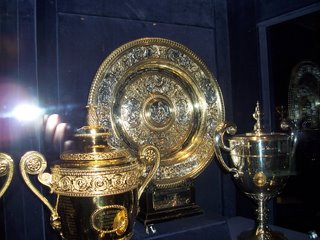
Pieter en Anca bly naby aan Wimbledon stadion. Daar is 'n tennis museum waar hulle selfs ons Bakers Tennis Beskuitjies het!
The Championships, Wimbledon
The Championships, Wimbledon, commonly referred to as simply "Wimbledon", is the oldest and most prestigious event in the sport of tennis. Held every June or July, the tournament is the third Grand Slam event played each year, preceded by the Australian Open and the French Open, and followed by the U.S. Open. The tournament (which is the only one of the Grand Slam events played on grass courts) lasts for a fortnight, subject to extensions for rain. Separate tournaments are simultaneously held for Gentlemen's Singles, Ladies' Singles, Gentlemen's Doubles, Ladies' Doubles and Mixed Doubles. Youth tournaments — Boys' Singles, Girls' Singles, Boys' Doubles and Girls' Doubles — are also held. Additionally, special invitational tournaments are held: the 35 and over Gentlemen's Doubles, 45 and over Gentlemen's Doubles, 35 and over Ladies' Doubles and wheelchair doubles.
History
The Championships were first played under the control of the All England Lawn Tennis and Croquet Club in 1877 at a ground near Worple Road, Wimbledon; the only event held was Gentlemen's Singles. In 1884, the All England Club added Ladies' Singles and Gentlemen's Doubles. Ladies' Doubles and Mixed Doubles were added in 1913. The Championships moved to their present location, at a ground near Church Road, in 1922. As with the other three Grand Slam events, Wimbledon was contested by top-ranked amateur players until the advent of the open era in tennis in 1968. Britons are very proud of the tournament but it is a source of national anguish and humour — no British man has won the singles event at Wimbledon since Fred Perry in 1936, and no British woman since Virginia Wade in 1977.
Events
There are five main events held at Wimbledon: Gentlemen's Singles, Ladies' Singles, Gentlemen's Doubles, Ladies' Doubles, and Mixed Doubles. In addition, four events are held for juniors: Boys' Singles, Girls' Singles, Boys' Doubles, and Girls' Doubles. (The Mixed Doubles event is not held at the junior level.) Finally, four invitational events are held: the 35 and over Gentlemen's Invitation Doubles, the 45 and over Gentlemen's Invitation Doubles, the 35 and over Ladies' Invitation Doubles, and the Wheelchair Gentlemen's Invitation Doubles.
Matches in the Gentlemen's Singles and Gentlemen's Doubles competitions are best-of-five sets; matches in all other events are best-of-three sets. Most events are single-elimination tournaments; in other words, a player who loses a single match is immediately eliminated from the tournament. However, the 35 and over Gentlemen's Invitation Doubles and the 35 and over Ladies' Invitation Doubles are both round-robin tournaments.
Each year, the tournament begins six weeks before the first Monday in August. It is held two weeks after the Queen's Club Championships, which is considered the major warm-up for Wimbledon for male players. Another important warm-up tournament for the men is the Gerry Weber Open, which is held in Halle, Germany at about the same time as the Queen's Club Championships. Wimbledon usually lasts for two weeks; the main events span both weeks, but the junior and invitational events are for the most part held during the second week. Traditionally, there is no play on the "Middle Sunday," which is considered a rest day. However, rain has forced play on the Middle Sunday thrice in Championships history: in 1991, 1997, and 2004. On each of these occasions, Wimbledon has staged a "People's Sunday", with unreserved seating and readily available, inexpensive tickets.
A total of 128 players feature in each singles event, 64 pairs in each single-sex doubles event, and 48 pairs in Mixed Doubles. Players and doubles pairs are admitted to the main events on the basis of their international rankings. The Committee of Management and the Referee evaluate all applications for entry, and determine which players may be admitted to the tournament directly. The committee may admit a player without a high enough ranking as a "wild card." Usually, wild cards are players who have performed well during previous tournaments, or would stimulate public interest in Wimbledon by participating. The only wild card to win the Gentlemen's Singles Championship was Goran Ivanisevic (2001); no wild card has ever won the Ladies' Singles Title. Players and pairs who neither have high enough rankings nor receive wild cards may participate in a qualifying tournament held one week before Wimbledon at the Bank of England Sports Ground in Roehampton.
The singles qualifying competitions are three-round events; the same-sex doubles competitions last for only one round. There is no qualifying tournament for Mixed Doubles. No qualifier has won either the Gentlemen's Singles or the Ladies' Singles tournaments; in 1977, John McEnroe went farther than any other qualifier in history by reaching the semifinals.
Players are admitted to the junior tournaments upon the recommendations of their national tennis associations, and, in the case of the singles events, on the basis of a qualifying competition. The Committee of Management determines which players may enter the four invitational events.
The Committee seeds the top players and pairs (thirty-two players in each main singles events, and sixteen pairs in each main doubles event) on the basis of their rankings. The defending champion is normally, but not always, seeded first. A majority of the entrants are unseeded.
Only two unseeded players have ever won the Gentlemen's Singles Championship: Boris Becker in 1985 and Goran Ivanisevic in 2001. No unseeded player has captured the Ladies' Singles title; the lowest seeded female champion was Venus Williams, who won in 2005 as the fourteenth seed. Unseeded pairs have won the doubles titles on numerous occasions; the 2005 Gentlemen's Doubles champions were not only unseeded, but also (for the first time ever) qualifiers.
Grounds
The order of play for all courts is displayed on boards around the groundsThe nineteen courts used for Wimbledon are all composed purely of rye grass. The speed and the low bounce of grass courts favours serve and volley players. Serve and volleyers such as Rod Laver, John McEnroe, Boris Becker, Stefan Edberg, and Pete Sampras have all won the Championships. However, baseliners such as Björn Borg have also performed very well, as have all-court players like Roger Federer. Among women, the serve and volley strategy is less common; one of the few female serve and volleyers, Martina Navrátilová, won Wimbledon on a record nine occasions.
The main show courts, Centre Court and No. 1 Court, are used only for two weeks a year, during the Championships. The remaining seventeen courts, however, are regularly used for other events hosted by the All England Lawn Tennis and Croquet Club. Wimbledon is the only Grand Slam event played on grass courts. At one time, all of the other Grand Slam events were played on grass. The French Open abandoned grass for its current red clay in 1928, while the U.S. and Australian Opens stayed with grass decades longer. The U.S. Open abandoned grass for a synthetic clay surface in 1975, and changed again to a hard surface with its 1978 move to its current venue. The Australian Open abandoned grass for a different type of hard surface in 1988.
The main court, Centre Court, was opened in 1922 when the All England Lawn Tennis and Croquet Club moved from Worple Road to Church Road. Due to possibility of rain during Wimbledon, a retractable roof is planned for the court; it is expected to be completed in 2009. The court has a capacity of almost 14,000; at its south end is the Royal Box, from which members of the Royal Family and other dignitaries watch matches. Centre Court usually hosts the finals and semifinals of the main events, as well as many matches in the earlier rounds involving top-seeded players.
The second most important court is No. 1 Court. The court was constructed in 1997 to replace the old No. 1 Court, which was adjacent to Centre Court, but was demolished because its capacity for spectators was too low. The original No. 1 Court was said to have a unique, more intimate atmosphere, and was a favourite of many players. The new No. 1 Court has a capacity of approximately 11,000. The third-largest court, No. 2 Court, has been dubbed the "Graveyard of Champions" due to its reputation as the court on which many seeded players have been eliminated during the early rounds. Famous players who have lost on the Graveyard during early round play include John McEnroe, Pete Sampras, and Serena Williams. The court has a capacity of about 3,000.
At the northern end of the grounds is a giant television screen on which important matches are broadcast. Fans watch from an area of grass officially known as Aorangi Park, but more commonly called Henman Hill. The "hill" takes its name from local favourite Tim Henman, whom many fans hope will become the first British man to win the tournament since Fred Perry did so in 1936. Due to Tim Henman's early exit and British newcomer Andy Murray's relative success in the 2005 Championship, the hill may be renamed as Murray Mound, Mount Murray, or Murray Field (after the Scottish rugby stadium).
Dark green and purple are the traditional Wimbledon colours. Green apparel is worn by the chair umpire, linesmen, ball boys, and ball girls. The All England Club requires players to wear "predominantly white" clothing during matches. No other Grand Slam tournament has such a strict dress code for players. During matches, female players are always referred to with the title "Miss" or "Mrs". (Formerly, married female players were referred to by their husband's names: for example, Chris Evert-Lloyd appeared on scoreboards as "Mrs. J. M. Lloyd" during her marriage to John M. Lloyd. However, this custom has been abandoned.) On the other hand, the title "Mr" is never used for male players.Previously, players bowed or curtsied to members of the Royal Family seated in the Royal Box upon entering or leaving Centre Court. In 2003, however, the President of the All England Club, HRH The Duke of Kent, decided to discontinue the tradition. Now, players are required to bow or curtsy only if the Queen or the Prince of Wales is present.For the spectators, strawberries and cream is the traditional snack at Wimbledon. Approximately 28,000 kilograms of strawberries and 7,000 litres of cream are sold each year during the Championships.Since 1992 Radio Wimbledon has broadcast commentary, speech and music from 7am to 10pm daily throughout the championship. It can be heard within a four-mile radius on 87.7 FM and also online.
Trophies and prize money
The Gentlemen's Singles champion receives a silver gilt cup 18.5 inches (about 47 cm) in height and 7.5 inches (about 19 cm) in diameter. The trophy has been awarded since 1887. It bears the inscription "The All England Lawn Tennis Club Single Handed Champion of the World." The Ladies' Singles champion receives a sterling silver salver commonly known as the "Venus Rosewater Dish," or simply the "Rosewater Dish."
The salver, which is 18.75 inches (about 48 cm) in diameter, is decorated with figures from mythology. The winners of the Gentlemen's Doubles, Ladies' Doubles, and Mixed Doubles events receive silver cups. The runner-up in each event receives an inscribed silver plate. The trophies are usually presented by the President of the All England Club, HRH The Duke of Kent, and by his wife, HRH The Duchess of Kent. At Wimbledon, more prize money is awarded in the Gentlemen's events than in the Ladies' events. This is justified by the rules that men must win 3 out of 5 sets to win a match, where as women only need to win 2 out of 3. The French Open also offers higher prize money for men, but the Australian Open and the U.S. Open provide parity.
The sums awarded to the winners of each of the main events in 2005 are as follows (the amounts shown for the doubles events are per pair):
Gentlemen's Singles: £630,000
Ladies' Singles: £600,000
Gentlemen's Doubles: £218,500
Ladies' Doubles: £203,250

